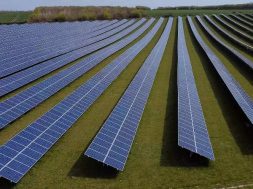
Major Breakthrough of Perovskite Solar Cell: Power Conversion Efficiency Rose to 20% and Water-induced Degradation Issue Was Solved
Perovskite solar cells (PSCs)has great potential because its power conversion efficiency can nearly match that of traditional silicon solar cell. However, there are two problems of perovskite: it is mechanically fragile and is degraded when exposed to water.
Currently, researchers in Qatar, Switzerland and Italy found all new water-resistant materials. This material will make PSCs more durable in the long term in the environment, raise power conversion efficiencies (PCE) of PSCs, and solve the problem of water-induced degradation.
PSCs is a promising material in solar PV cell segment. Its efficiency rate grew 6 fold in just 9 years, from 3.81% to impressive 22.7% nowadays. Many scientists have worked on tandem design of perovskite solar cells, silicon solar cells, and copper indium gallium selenide (CIGS) solar cells. Some of the hybrid combination has set new records for efficiency levels.
The sources of PSCs are abundant. Its manufacturing processes are not as complicated as that of silicon solar cell. For example, silicon solar cell’s manufacturing processes typically require heat above 900 Celsius degrees, but PSCs only need about 100 Celsius degrees. In the future, a printable manufacturing process can make light-weighted and flexibleperovskite film solar cell.
Let’s talk about PSCs’ commercialization. PSC’s sources for materials are abundant, and conversion efficiency has been growing astonishingly. PSCs are supposed to rapidly achieve commercialization.
However, perovskite will deteriorate by moisture, heat, oxygen, and ultraviolet, so PSCs must be encapsulated to prevent water-induced decomposing. The industry is competing to develop effective water-proof materials for PSCs. In other words, in terms of stability and life span, a silicon PV cell is better than that of a PSC.
In order to improve the efficiency of PSC, the united research team of Qatar, Switzerland and Italy allows a layer of two-dimensional perovskite to self assemble on top of three-dimensional perovskite layer. This move makes a mixed low-dimensional 2D/3D composite perovskite PV cell. This structure successfully repels water and prevents moisture-induced degradation. In humid air, this PSC was exposed for three days, and the water-induced decomposition did not happen.
Image:NANO LETTER
There are two advantages of new composite perovskite PV cell. Firstly, the efficiency will reach above 20%. Secondly, because of the improved water resistance feature, perovskite solar cell’s efficiency can last up to 200 hours. The research’s co-author Mohammad Khaja Nazeeruddin of Ecole Polytechnique Fédérale de Lausanne (EPFL) expressed that this material can be used for light-emitting diodes (LED) and photodetectors.
Nowadays, many manufacturers and institutes are putting effort into enhancing water-proof feature of perovskite solar cells. For instance, Solliance, European thin-film solar research alliance, is one of them. Solliance announced that its perovskite film’s conversion efficiency surpassed 13.5% in November 2017. Because many research institutes and manufacturers anticipate perovskite solar cells’ great potentials, their effort will help this technology commercialize in the future.
The next goal of this jointed research team is to continue optimizing the materials’ features and expanding the application ranges of the materials. This new research is published on NANO LETTER.
















